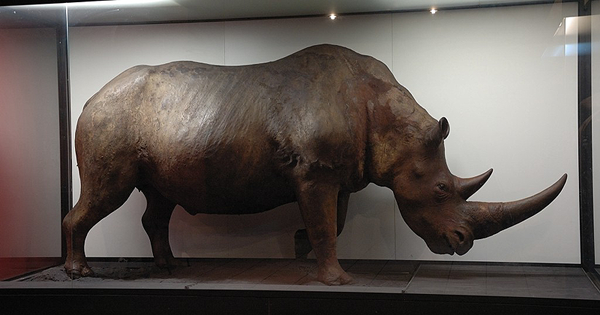The woolly rhinoceros Coelodonta antiquitatis from Starunia

The woolly rhinoceros (Coelodonta antiquitatis) is an extinct mammal species from the Late Pleistocene that occurred throughout Eurasia, from the Pyrenees to Siberia. Aside from the woolly mammoth, it was the largest herbivore of the ice ages. The woolly rhinoceros consumed mostly grasses and lichens. Adults were about 2 meters in height, 5 meters in length and weighed approximately 3.5 tons. Dense fur and thick, long hair on the body protected these animals from heat loss during the severe winters of the glaciations. The head, narrowing towards the front, was equipped with two huge horns.
The exceptional state of preservation of the woolly rhinoceros from Starunia, complete with internal organs and soft tissues, makes the specimen housed in the Natural History Museum of the Institute of Systematics and Evolution of Animals of the Polish Academy of Sciences on St. Sebastian Street one of the most valuable specimens in the world. The preservation of the body of the rhino was possible because of the brine deposits and mineral wax (ozokerite) occurring at the site. The Museum houses the mounted skin of the woolly rhino, a reconstruction of its skeleton prepared by Jan Stach, as well as a gypsum cast showing the original position of the animal at the Starunia site.
From the middle of the XVIII only several, usually small fragments of woolly rhinoceros bodies have been unearthed. Up to now, the specimen from Starunia is the only completely preserved specimen in the world, including organs and soft tissues. The discovery was made in 1929 in a village in contemporary Ukraine, about 100 km to the southeast of Lvov. The specimen is a young female that died about 30 thousand years ago. The reconstruction of the rhino was performed according to the concept of prof. Jan Stach in 1929, using the authentic skin of the animal prepared from the carcass. Unfortunately the hooves and horns of the rhino have not endured, and its hair has persevered only on small fragments of skin. The silhouette of the rhino was quickly adopted as the logo of the Museum.
The remains of plants, insects and small vertebrates found together with the Starunia rhino have helped to elucidate the environment and climate of the Pleistocene in the foothills of the Carpathians.